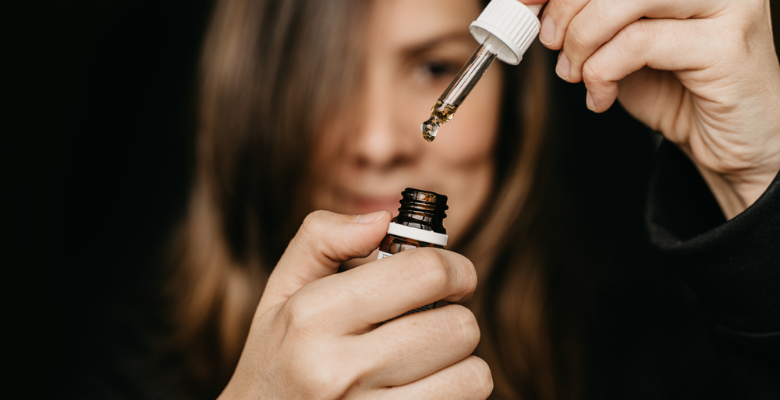Have you ever heard of phytocannabinoids? Although most people only know THC and CBD, Cannabis has more than 500 different chemical compounds,, among which more than 150 are called phytocannabinoids. They are capable of producing different physiological effects and with therapeutic potential.
These compounds are synthesized in secretory cells within glandular structures called trichomes in female Cannabis flowers. Male plants also have cannabinoids, but in much lower amounts than those found in female plants.
Why is it important to know more about phytocannabinoids?
The Cannabis plant is much more than CBD and THC. It represents a complex chemical scenario of more than 500 chemical elements, most of them with therapeutic potential. Learn about the potential uses of other phytocannabinoids, not as well-known and explored as CBD and THC:
CBC
Among the possible effects of cannabichromene (CBC) is an antidepressant action. This is reinforced in a 2011 study, which shows the potential of CBC and other cannabinoids to elevate mood.
In 2006, the Journal of Pharmacology and Experimental Therapeutics published a study that examined the effects of cannabinoids on in vitro breast cancer cells. CBD was considered the most potent inhibitor of the growth of these cells, but it was followed by CBC and CBG, which also showed good results.
>> Read more: Antitumor activity of plant cannabinoids with emphasis on the effect of cannabidiol on human breast carcinoma
CBDA
Cannabidiolic acid (CBDA) is the acidic form of CBD. The compound shows interesting potential to inhibit nausea and vomiting. This is what a research with animal models indicated, in which the phytocannabinoid proves to be more potent than cannabidiol for this purpose. CBDA can bring benefits even for anticipatory nausea, for which there is currently no specific therapy.
CBDA has also shown potential in inhibiting the migration of cancer cells, including aggressive breast cancers. This finding is from a 2012 study that demonstrates the ability of CBDA to be an inhibitor of MDA-MB-231 invasive breast carcinoma cell migration, apparently through a mechanism that involves the inhibition of cyclic AMP-dependent protein kinase A.
>> Learn more at Cannabidiolic acid, a major cannabinoid in fiber-type cannabis, is an inhibitor of MDA-MB-231 breast cancer cell migration
CBG
The glioblastoma is considered the most aggressive primary brain cancer. In February 2021, a study was published evaluating the use of cannabigerol (CBG) to prevent disease progression. The cytotoxic, apoptotic and anti-invasive effects of this cannabinoid, along with CBD and THC, on glioblastoma tumor cells and glioblastoma stem cells were compared. The compounds CBG and THC reduced the viability of both cell types to a similar extent, while the combination of CBD with CBG was more efficient than with THC. CBD and CBG, both alone and in combination, induced caspase-dependent cellular apoptosis. The authors suggest further studies combining CBD and CBG in the treatment of the disease.
>> See the study Cannabigerol Is a Potential Therapeutic Agent in a Novel Combined Therapy for Glioblastoma.
This was not the first study to demonstrate the antineoplastic potential of cannabinoids in multiform glioblastoma. As we have already covered in this content on Cannabis and Cancer here on the blog, another study, published in 2021, points out the antitumor effects of the formulation based on Cannabis nabiximols in fighting multiform glioblastoma (GBM) – also known as grade IV glioblastoma, which is the most common and aggressive type of malignant brain tumor among humans. The partial results of this clinical trial show that the 1-year survival rate for patients who used cannabis extract was 83%.
>> Read the article A phase 1b randomised, placebo-controlled trial of nabiximols cannabinoid oromucosal spray with temozolomide in patients with recurrent glioblastoma | British Journal of Cancer
CBG can also act as an appetite stimulant. A British research with rats divided the animals into two groups and found that those who received cannabigerol ate twice as much as those who took a placebo. No relevant side effects were recorded.
>> Read at Cannabigerol is a novel, well-tolerated appetite stimulant in pre-satiated rats
CBN
Cannabinol, or CBN, is a compound derived from the oxidation of delta-9-THC. Therefore, it is normally present in larger amounts in cannabis extracts stored for a long time.
It has medicinal potential in chronic muscle pain disorders, such as temporomandibular disorders and fibromyalgia. This is what this 2019 research, carried out with animal models of rats demonstrated.
Other study with rodents identified that CBN can delay the onset of symptoms of Amyotrophic Lateral Sclerosis (ALS) This phytocannabinoid has been shown to be an important neuroprotector and may contribute to the treatment of neurodegenerative diseases.
>> Read more: Cannabinol delays symptom onset in SOD1 (G93A) transgenic mice without affecting survival
Delta-8-THC
Despite its similar name, delta-8 THC is a compound with properties very different from those of THC (or delta-9 THC). The similarity between the two is because they have a similar structure, with only a few differences in chemical bonds.
Delta-8 THC has shown potential in reducing corneal pain and inflammation. In a study carried out in an animal model, it was noted that the application of this compound in corneal lesions in mice showed antinociceptive and anti-inflammatory actions, decreasing pain score and local neutrophil infiltration.
>> Learn more: The Cannabinoids Δ8THC, CBD, and HU-308 Act via Distinct Receptors to Reduce Corneal Pain and Inflammation
There are studies that explored the anti-emetic potential of delta-8 THC as far as 1995. A research administered this phytocannabinoid to eight children aged between 3 and 13 years, with different types of cancer of hematologic origin. Ingestion occurred two hours before each antineoplastic treatment, being repeated every 6 hours for 24 hours. Vomiting was completely avoided and the side effects observed were considered negligible.
>> See: An efficient new cannabinoid antiemetic in pediatric oncology
THCA
Tetrahydrocannabinolic acid (THCA) is the acid form of THC, naturally present in the plant, before the decarboxylation process. Interestingly, this phytocannabinoid has no psychoactivity. There are still few studies on this cannabinoid, but it has extremely promising medicinal properties. In a 2019 researchthe researchers concluded that THCA could substantially improve the symptoms of metabolic syndrome associated with obesity and inflammationby preventing hepatic steatosis, adipogenesis, and macrophage infiltration into adipose tissues.
Other study demonstrates that THCA has relevant neuroprotective activity, which is worth considering for the treatment of Huntington’s disease and possibly other neurodegenerative and neuroinflammatory disorders.
>> Learn more: Tetrahydrocannabinolic acid is a potent PPARγ agonist with neuroprotective activity
THCV
THCV or tetrahydrocannabivarin is a compound analogous to THC. Some preclinical studies indicate that this phytocannabinoid antagonizes THC at the CB1 receptor at doses below 3 mg/kg, but acts as a CB1 receptor agonist at doses above 10 mg/kg. THCV has been shown to be effective in experimental models of epilepsy by increasing the release of GABA, an inhibitory neurotransmitter of the central nervous system.
A 2020 study of mice suggests that THCV also has the potential to inhibit levodopa-induced dyskinesia, both to delay its occurrence and to alleviate symptoms. Although more studies are needed to determine the clinical significance of the data in humans, the results indicate that using THCV in the treatment of patients with Parkinson’s disease may be promising.
>> Learn more at Beneficial effects of the phytocannabinoid Δ 9-THCV in L-DOPA-induced dyskinesia in Parkinson’s disease
These are just a few examples of how different phytocannabinoids can be useful in medical practice. If you want to learn more about the topic and are interested in expanding your therapeutic arsenal, and prescribing medical cannabis for your patients, check out our International Certification in Endocannabinoid Medicine. We have experts from around the world, combining highly qualified scientific knowledge and practical experience.
References
Abrahamov A, Abrahamov A, Mechoulam R. An efficient new cannabinoid antiemetic in pediatric oncology. Life Sci. 1995;56(23-24):2097-2102. doi:10.1016/0024-3205(95)00194-b
Babson KA, Sottile J, Morabito D. Cannabis, Cannabinoids, and Sleep: a Review of the Literature. Curr Psychiatry Rep. 2017;19(4):23. doi:10.1007/s11920-017-0775-9
Baron EP. Medicinal Properties of Cannabinoids, Terpenes, and Flavonoids in Cannabis, and Benefits in Migraine, Headache, and Pain: An Update on Current Evidence and Cannabis Science.. Headache. 2018;58(7):1139-1186. doi:10.1111/head.13345
Bolognini D, Rock EM, Cluny NL, et al. Cannabidiolic acid prevents vomiting in Suncus murinus and nausea-induced behavior in rats by enhancing 5-HT1A receptor activation.. Br J Pharmacol. 2013;168(6):1456-1470. doi:10.1111/bph.12043
Brierley DI, Samuels J, Duncan M, Whalley BJ, Williams CM. Cannabigerol is a novel, well-tolerated appetite stimulant in pre-satiated rats. Psychopharmacology (Berl). 2016;233(19-20):3603-3613. doi:10.1007/s00213-016-4397-4
El-Alfy AT, Ivey K, Robinson K, et al. Antidepressant-like effect of delta9-tetrahydrocannabinol and other cannabinoids isolated from Cannabis sativa L. Pharmacol Biochem Behav. 2010;95(4):434-442. doi:10.1016/j.pbb.2010.03.004
Espadas I, Keifman E, Palomo-Garo C, et al. Beneficial effects of the phytocannabinoid Δ9-THCV in L-DOPA-induced dyskinesia in Parkinson’s disease. Neurobiol Dis. 2020;141:104892. doi:10.1016/j.nbd.2020.104892
Lee MC, Ploner M, Wiech K, et al. Amygdala activity contributes to the dissociative effect of cannabis on pain perception. Pain. 2013;154(1):124-134. doi:10.1016/j.pain.2012.09.017
Ligresti A, Moriello AS, Starowicz K, et al. Antitumor activity of plant cannabinoids with emphasis on the effect of cannabidiol on human breast carcinoma. J Pharmacol Exp Ther. 2006;318(3):1375-1387. doi:10.1124/jpet.106.105247
Nadal X, Del Río C, Casano S, et al. Tetrahydrocannabinolic acid is a potent PPARγ agonist with neuroprotective activity. Br J Pharmacol. 2017;174(23):4263-4276. doi:10.1111/bph.14019
Palomares B, Ruiz-Pino F, Garrido-Rodriguez M, et al. Tetrahydrocannabinolic acid A (THCA-A) reduces adiposity and prevents metabolic disease caused by diet-induced obesity. Biochem Pharmacol. 2020;171:113693. doi:10.1016/j.bcp.2019.113693
Russo EB, Guy GW, Robson PJ. Cannabis, pain, and sleep: lessons from therapeutic clinical trials of Sativex, a cannabis-based medicine. Chem Biodivers. 2007;4(8):1729-1743. doi:10.1002/cbdv.200790150
Takeda S, Okajima S, Miyoshi H, et al. Cannabidiolic acid, a major cannabinoid in fiber-type cannabis, is an inhibitor of MDA-MB-231 breast cancer cell migration. Toxicol Lett. 2012;214(3):314-319. doi:10.1016/j.toxlet.2012.08.029
Thapa D, Cairns EA, Szczesniak AM, Toguri JT, Caldwell MD, Kelly MEM. The Cannabinoids Δ8THC, CBD, and HU-308 Act via Distinct Receptors to Reduce Corneal Pain and Inflammation. Cannabis Cannabinoid Res. 2018;3(1):11-20. Published 2018 Feb 1. doi:10.1089/can.2017.0041
Weydt P, Hong S, Witting A, Möller T, Stella N, Kliot M. Cannabinol delays symptom onset in SOD1 (G93A) transgenic mice without affecting survival. Amyotroph Lateral Scler Other Motor Neuron Disord. 2005;6(3):182-184. doi:10.1080/14660820510030149
Wong H, Cairns BE. Cannabidiol, cannabinol and their combinations act as peripheral analgesics in a rat model of myofascial pain. Arch Oral Biol. 2019;104:33-39. doi:10.1016/j.archoralbio.2019.05.028




